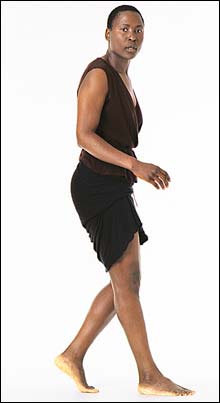
NORA CHIPAUMIRE: Her dancing hits you with a vengeance.
|
It’s hard to imagine a more diverse assemblage of bodies, temperaments, and performing presences than the roster for this year’s “Three Women Solo” at Summer Stages Dance. The idea for a mini-gala of powerhouse female talent was dreamed up by Summer Stages co-director Richard Colton three years ago; the concert a week ago Thursday featured Risa Steinberg, a small, tensile inheritor of the Juilliard-Limón tradition, Nora Chipaumire, a fierce, imposing native of Zimbabwe, and the elegant, long-lined Canadian Peggy Baker.
The components of the program — three modern-dance portraits danced by Steinberg, two stagings of a proud, resistant identity by Chipaumire, and a long dance memoir by Baker — reflected one another in a three-part synergy of movement abstraction and personal witness.
Risa Steinberg has been uncovering and reanimating the forgotten repertory of the great modern dancers for 20 years. In Wrath, one of the four deadly sins depicted in Eleanor King’s 1941 Roads to Hell, she wore a long gray shift, with her hair frizzed out like wires. She swept her arms through space, slapped her thighs and sprang vertically into the air, beckoned to the audience with a crooked finger and a deceptive smile, then silently pounded the floor and collapsed.
Anna Sokolow’s Kaddish (1945) appropriated the role of mourner that traditionally belongs to men in the Orthodox Jewish tradition. Wearing ritual tefillin wrapped around one arm, Steinberg bent deeply backward, beat her chest with her fists, thrashed and spun in an ecstasy of grief. Sokolow may have meant to dedicate her prayer to the dead of World War II, but today one can’t help seeing this outcry in relation to the catastrophic events in the Middle East.
Nora Chipaumire is even closer to the horrors of warfare and victimization of the innocents. Whether she’s dancing about Convoys, Curfews, and Roadblocks (a work in progress) or a woman’s defensive poses and idealized roles (Dark Swan), her dance boils with suppressed anger and eroticism. She seems to be reliving a stream of bitter memories, excruciating images, and crafty retorts. Her dancing hits you with a vengeance.
ADVERTISEMENT
 |
In Convoys, she hovers on one leg at the edge of a red-lit square on the floor — a jail cell? a room in flames? She clutches her abdomen and her crotch in spasms of agony, throws punches and invisible rocks at an invisible enemy, looks around warily, saunters insolently along a mean street.
Dark Swan begins with Saint-Saëns’s Dying Swan music, and Chipaumire dances a distant inheritance, perhaps from Pavlova. At first flailing and faltering along a diagonal pathway, she’s a vision coming apart. Breathing heavily, she crawls and struggles to stay upright. As the music ends, she shivers ecstatically and undergoes a kind of conversion in silence. Then she mimes what looks like putting on make-up and, retreating to a different diagonal, dances a seductive Odile, a temptress in triumphant command of her body.
The talking dances that followed this were also about memory, but memory tightly contained by form and unable to cause harm. Directed by Ann Carlson, Too Beautiful a Day (2001) has a text collage where Steinberg intercuts an eye-witness account of a prisoner’s electrocution with ironic, mundane apartment stories. Confronting the unthinkable, the mind rushes on, changes the subject. Dressed in a huge American flag, Steinberg sat in a chair and gestured obsessively, rolling out dough or smoothing laundry, hedging against chaos.
Peggy Baker also assembled memories from her life for The Disappearance of Right and Left, which was choreographed and directed by Sarah Chase. Baker told stories about her father’s childhood, her life as an Alberta girl, her classes with Martha Graham, her traumatic love life. A series of semaphoric moves propelled her into big swooping, scooping rushes and lyrical traverses, but the dance didn’t seem any more stringently edited than the rambling text. It was like a sidewalk conversation with a gabby neighbor.